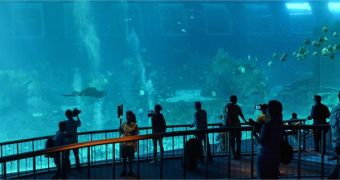The news that Singapore is presently home to the world's largest aquarium is now causing quite a media stir. The S.E.A. Aquarium first opened its gates in late November, but it took a few days before it started turning some heads.
Up until now, it was the Georgia Aquarium, which opened back in 2005, the one that held this record. Still, the Georgia Aquarium only has 10 million gallons of water to show off, whereas this aquarium on the resort island of Sentosa packs roughly 12 million gallons.
This facility is home to as many as 100,000 marine animals belonging to 800 different species. As well as this, it recreates 49 types of aquatic natural ecosystems distributed amongst 10 different zones, sources say.
The people in charge of running the S.E.A. Aquarium explain that their main goals are raising awareness with respect to the need to protect marine ecosystems, and educating the general public about life under the sea.
As Senior Curator Grant Willis puts it, “S.E.A. Aquarium offers not only a stunning display of habitats, but also education and conservation programs in which families and guests can participate.”
“Younger guests will be thrilled to know that we have specially-designed exhibits such as the Discovery Touch Pool, the Lens Aquarium and Floor Aquarium, to provide them up-close encounters with our marine residents,” he went on to add.
However, as is the case with almost all such man-made homes for wildlife representatives, several conservationists are now busy arguing that the animals housed at this aquarium belong in the wild and should not be kept in captivity.
Their main focus is on the 25 dolphins that now call this facility their home.
However, a spokesman for the S.E.A. Aquarium wished to emphasize that, “We hold the belief that zoological organizations have a role to play in wildlife conservation and that to avert species crises, controlled wildlife collections can occur for quality zoological facilities to increase our understanding of the species and for breeding purposes”
In case anyone was wondering, adults wishing to visit this aquarium will have to pay $24 (€18.35), whereas children and senior citizens can get in for just $16 (€12.23).

 14 DAY TRIAL //
14 DAY TRIAL //